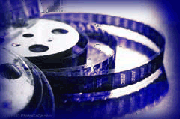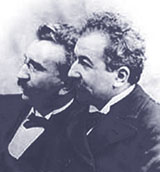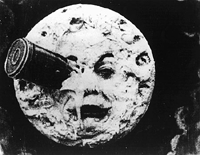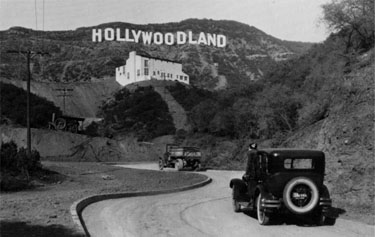
Early Film History
Moving Pictures
Film, as we know it, is not actually moving pictures at all. It is a series of still images moved together very quickly (@ 50 frames per second) in order to fool our eyes and brains that they represent moving objects. This is what's known as a
and is sometimes termed 'persistence of vision'. The concept was identified in 1824 by Peter Mark Roget, a British scientist.
Who invented it?
For cinema to come into existence, there first of all had to be still pictures, otherwise known as photography. This was first presented to the world by Parisians Joseph Niepce & Louis Daguerre (who managed to create images on plates of metal) in 1839, and further developed by Englishman William Fox Talbot, who discovered how to put photographic images onto paper.
Read about the
- Beginnings of Photography
- Daguerre & Niepce
- Fox Talbot (and look at some of his early photographs here)
The 1830s also saw the invention of 'toys' which involved spinning images which gave the illusion of motion (Michael Faraday's Wheel of Life or zoetrope, Joseph Plateau's Phenakistoscope, and Simon Ritter von Stampfer's Stroboscope). These are all very simple devices which play with the idea of putting many still images together to make one moving one. Learn how to make your own Phenakistoscope here.
It wasn't long before people came up with the idea of combining the two.
This was the amount of money bet by Governor Leland Stanford (founder of the University) of California in 1872. He had a theory that when a horse was galloping there was a point when it had all of its hooves off the ground at once. He employed English photographer Eadweard Muybridge set up a series of tripwires at Palo Alto racecourse to take a sequence of images in motion. In 1879 Muybridge produced what would be the first in a series of 'Studies in Animal Locomotion', and Stanford won his bet. You can see the early images Muybridge produced by clicking here.
"I am experimenting upon an instrument which does for the eye what the phonograph does for the ear, which is the recording and reproduction of things in motion ...."
--Thomas A. Edison, 1888
In the meantime, French scientist Etienne-Jules Marey was experimenting with revolving metal plates, and then strips of photographic film supplied by Kodak, in order to achieve some form of projection. Thomas Edison was also working at this - and tried to imitate the Phonograph, with pictures instead of sound, but failed. His assistant, William Dickson, invented a camera in 1890 called the Kinetograph and another machine for viewing the footage taken with this camera called the Kinetoscope. This was an instant hit - Kinetoscope parlours opened across America in 1894, showing films as short as 15 seconds. Read more about Edison & Dickson's inventions (and see one of their early films - 'The Sneeze') here.
There is a lot of argument about whether Edison's machine produced the first motion pictures, or whether it was the Lumiere Brothers' Cinematograph which produced the first version of 'the movies' that we know today. That's why cinema-lovers didn't know whether to celebrate its centennial in 1994 or 1995 - it depended if you were European or American! Anyway, Auguste & Louis Lumière first combined the Kinetoscope and the Magic Lantern and projected moving pictures in the basement of the Grand Café in Paris on 28 December 1895. Many other inventors were developing a similar apparatus but the Lumière Brothers beat them to it. They had devised a portable, hand-cranked camera which was soon able to capture and project 15-20 second films of action from around the world.
Find more about the Lumière Brothers and their invention at these sites:

"Our invention can be exploited for a certain time as a scientific curiosity, but apart from that, it has no commercial future whatsoever." — Auguste Lumière
The Lumière Brothers' invention was more popular and more powerful than they ever dreamed. Audiences were blown away by the replication of slices of reality that were presented to them.
Think for a second of what it would be like to see a photograph move for the first time. It's hard to think what it was like to see the first films ever made in 1895 because there has always been film and television in our lives. Even as babies we are subject to moving pictures and think nothing of it. That is why the first films ever made had such an impact on audiences. In Lumiere's Train Entering a Station the film had a train coming at the audiences at an angle which to early audiences felt like the train was really going to run them over. Audiences also marveled over "trick" shots in Destruction of a Wall which showed workers demolishing a wall and then the Lumiere brother reversed the film making it seem like the workers were putting the same wall back together again. We've seen it before for example of people jumping in the water and then jumping straight up out of the water. In the The Hoser Hosed the Lumiere brothers made one of the first "story films" or narratives. The film was a comedy about a kid stepping on a gardener's hose and then stepping off it when the gardener looks at the hose making him get all wet.
Eric Hasman (The Film Critiquer)
Soon, the brothers were sending film crews around the world, and Cinematographs were springing up everywhere. Although the cinema industry is said to have been born in France in 1895, it was only a matter of months before cinema was being made in America, India, Britain, and even Australia. Now that all the hardware was available, a whole bunch of people had to invent 'the movies' themselves. They had to work out how to tell a story across 24 frames per second, using shots that were no more than 20 seconds long (the maximum amount of film you could run through a camera at once). Film was initially considered just another fairground attraction, but it did not take long for it to become an art.
The First Film-makers
After the public had got over their initial delight at seeing trains pull into stations, or ships dock in Sydney Harbour, they began to demand STORIES. Studios soon went into production, with comedies and romances being the most popular form. You can read about some of the film-makers here:
- Thomas Edison - includes a link so that you can download some of his movies)
- Georges Méliès - started off as a magician and ended up inventing the science fiction film)
- Edwin S Porter (credited with inventing storytelling in film as we know it today, cutting between one sequence of action and another)

With nickleodeons opening across America in 1900, and cinema audiences being wowed with the early hit The Great Train Robbery (1903), cinema was definitely here to stay!
For lots of images and info on the whole process of inventing the cinema, look at theses sites:
- The Complete History of the Discovery of Cinematography
- Cinematographica - vintage movie cameras & projectors
Your task is to produce a booklet, aimed at Year 7, about the beginnings of film history. You should include
- Brief details of the inventors involved in its creation, outlining what their contriibution was
- An eyewitness account of a member of the Lumiere's audience in Paris on 28 December 1895
- Photographs of the early equipment used, plus explanations
- A review of an early film (from before 1905)
Use publisher to create an A4 (folded) leaflet. Check EXTREMELY carefully for spelling mistakes. You will be marked on
- the quality of your language (remember it is aimed at Year 7s so it must be clear and simple)
- the selection of information
- the
presentation of information

Hooray For Hollywood - A WebQuest
Most Westerners now associate film production with Hollywood, on the West Coast of the US and for many of the early years of the 20th century it was the home of some of the world's biggest movie studios. While Los Angeles as a whole is still a centre for film production, only Paramount still has premises in this city, as all the other studios have moved to Burbank. However, a great deal of glamour is still attached to the name Hollywood, and it has become a by-word for stars and scandal.
But why Hollywood and not anywhere else? Back in the 1890s it was a sleepy village, with a primary industry of fruit-growing. A combination of geography (Hollywood is close to a range of different landscapes for location shooting), meterology (very little rain) history (World War I halted movie production in Europe) and a certain lawlessness in the early days (it wasn't subject to the same restrictions as New York and Chicago) made it the choice of pioneering film-makers such as Cecil B DeMille. It had one of the first purpose built movie theatres (Tally's Electric Theatre in 1902), By the early 1920s it was home to all the major studios and stars and was pumping out 100s of movies per year.
You are writing a feature article for the Hollywood Reporter dated 1918 on the phenomenon of Hollywood as a boomtown. You should observe all the rules of newspaper writing and layout. Your headline is Hollywood Forever and you are writing about how successful your town has become.
You should include
- one or two paragraphs summarising how the town has grown since 1908
- an interview with one of the studio owners explaining their success
- images of Hollywood in this period
- comments from local people who have managed to find jobs in this new industry
- a final paragraph which looks to the future, making predictions for the next ten years.
Use these sites to help you gather information for your article. Remember that selection of key facts is essential - you do not want to bore your reader by regurgitating lots of irrelevant information. However, you must take care to be historically accurate. You are writing in 1918 so ensure you do not include any information from after that date:
- In The Beginning - from hollywoodmegastore
- The Origins Of Hollywood - an excellent article that will give you lots of information
- A Virtual Tour of some of the early studios (still working buildings today)
- The Hollywood Heritage Museum
- Wikipedia entry on Hollywood
Find out more about key players from the early days at these sites
or look them up in Wikipedia or Encarta online.

If you want to know more, just use a key word in the box below to search the rest of the Mediaknowall site.

